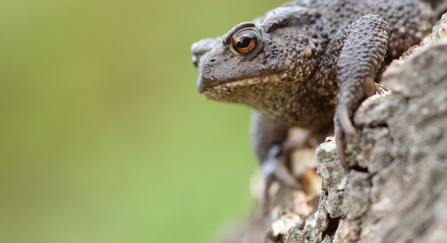After being all but destroyed by peat extraction for use in horticulture, Little Woolden Moss is bouncing back to life and is already home to loads of amazing wildlife. Lapwing and curlew breed in this boggy wilderness whilst hobby and merlin soar overhead, butterflies and dragonflies dart around the undergrowth, and our mammalian visitors range from tiny field voles to majestic roe deer.
Creating a hibernaculum at Little Woolden Moss
Common lizard by Tom Marshall

Common toad - Tom Marshall
And what about our cold-blooded inhabitants? Common toads and frogs can be seen hopping around in summer, and if you’re lucky you may just spot a common lizard basking along the side of the footpath.
But what happens to reptiles and amphibians in winter? As the temperature drops they head off and find somewhere to hibernate the winter months away. Some frogs will spend the winter lurking down in the mud at the bottom of ponds, breathing through their skin, but most other reptiles and amphibians will burrow away somewhere underground, in a sheltered and hidden spot.
So, to give the frogs, toads and lizards living at Little Woolden Moss a helping hand we have created a brand new hibernaculum for them.

Hibernaculum at Little Woolden Moss
From the Latin ‘hibernacula’ or ‘winter quarters’, these are purpose-built hibernation hidey holes. Dug into the ground and covered with a nice thick layer of soil and plants they will stay warm enough to protect these precious little creatures until spring.
How do you build a hibernaculum?
Our hibernaculum stared with a long trench dug into the heathland area that sits along the fringes of the area of lowland raised peat bog. This was then filled with rocks and stones to create lots of little nooks and crannies, just right for our hibernating friends to squeeze into (they love, and can fit into, surprisingly tiny spaces!).
The hibernaculum is filled with rocks and wood to provide small spaces for animals to hibernate in.
A layer of logs and sticks was then laid over the top, before this was covered with a thick layer of the peaty soil dug from the trench to act as insulation. Small gaps were left to allow the toads and lizards to get in and out.
And that’s about it – this simple structure took only a few hours to construct but will help protect our precious wildlife right across winter.
What about other animals and other times of the year?
We wanted to ensure that our hibernaculum wasn’t simply a one season wonder, so we added a few modifications to give it year-round appeal, and to more than just reptiles.
At one end of the structure we mixed the soil with plenty of sand to make it nice and easy for solitary bees to dig their homes into. Of the approximately 270 species of bees in the UK, around 250 of them are solitary bees, who dig nest holes in the ground into which they lay their eggs.
The metal basking plate is perfect for reptiles in summer and the sandy area is ideal for solitary bees to build their nests
We also though about our vital pollinators by planting the hibernaculum and the area around it up with lots of lovely native wildflowers, including cross-leaved heath, common heather, tormentil, bird’s foot trefoil, devils bit scabious, bilberry, crowberry and heath speedwell.
And finally, we didn’t forget about our reptiles and amphibians in summer too. Being cold-blooded, they need to bask to keep themselves warm and active, so we placed a ridged metal plate on the sunniest side of the hibernaculum to give them a lovely warm basking spot.
Thanks to Tyrer Ecological Consultants Biodiversity Improvement Grant for funding this fantastic addition to our wonderful nature reserve.
How can you help?
You can do your bit to help to save our precious peatlands and the wonderful wildlife that calls them home by going #PeatFree in your garden.

